The Northampton shoemaker who caught the Auschwitz commander
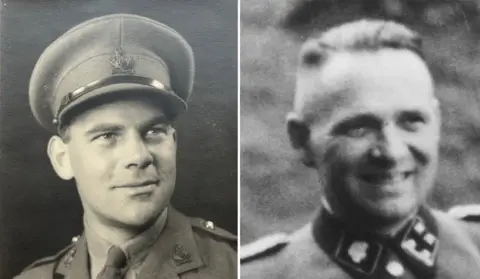 Cross family/Getty Images
Cross family/Getty Images"Father never spoke to us children about the war, so it wasn't until after he died that we realised how important his work had been."
William Cross was not yet born when his father, Capt Victor Cross, was among senior British soldiers who caught Rudolf Höss, the former commander of Auschwitz concentration camp, who had gone on the run at the end of World War Two.
Höss was a key figure culpable in the deaths of millions of Jewish people.
But how did a Northampton leather merchant come to find him, and what role did he play?

Victor Cross worked in the family business - the British Chrome Tanning Company - in Northampton, before the war.
He travelled widely, purchasing hides for the high-quality women's shoes the company made.
His father sent him to Germany to learn more about the trade, and Victor became fluent in the language while there.
When World War Two broke out in 1939, he joined the British Army, later moving to the Intelligence Corps, which was keen to recruit German speakers.
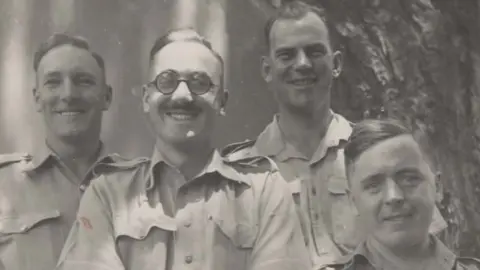 Courtesy of Military Intelligence Museum
Courtesy of Military Intelligence MuseumAt the end of the war, Capt Cross was sent to Germany in command of 92 and 95 Field Security Sections and, with others, was tasked with capturing escaped Nazis.
Among the thousands of names on a list given to them was Rudolf Höss - sometimes referred to as Hoess.
Rudolf Franz Ferdinand Höss had joined the Nazi Party in the early 1920s and later became an SS officer, working at a concentration camp at Dachau, before transferring to Auschwitz, which he ran until 1943.
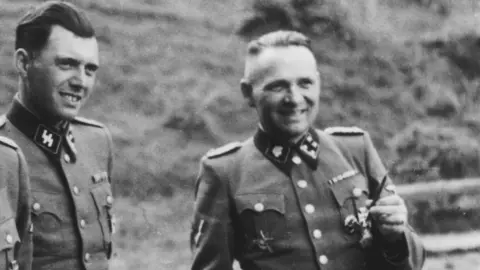 Getty Images
Getty ImagesHe went on to inspect other camps and assess their methods.
About six million Jews died in the Holocaust - the Nazi campaign to eradicate Europe's Jewish population - and Auschwitz was at the centre of that genocide.
But Höss made his own escape at the end of the war.
In an official Army report dated 15 March 1946, Capt Cross detailed how his team and others came to root out Höss.
"After five months of continuous investigations, interrogations and extensive searches, this section has succeeded in arresting SS Obersturmbannführer Hoess, Rudolf Franz Ferdinand who commanded the notorious Auschwitz concentration camp which was built under his supervision," he wrote.
 Cross Family
Cross FamilyHe told how Höss's wife, Hedwig, and their children had been found at a sugar factory where she was working in St Michaelisdonn.
She stated she had last seen her husband in April 1945 and that he had died.
Convinced she was lying, Capt Cross's team interrogated her several times.
After six days, "she finally broke down" and gave the address where her husband was staying, the captain wrote.
Working with another unit, Capt Cross's team surrounded the farmhouse near Flensburg in northern Germany - close to the Danish border - late on 11 March 1946 and "Höss was surprised in his pyjamas".
 Getty Images
Getty ImagesThe former commander had been living and working at the farm under the alias Franz Lang, "but admitted his true identity within 10 minutes of his arrest", wrote Capt Cross.
Höss gave a statement "in a very matter of fact way and it appears is quite willing to give information", he said.
Concluding his report, Capt Cross wrote that Höss "must be regarded as one of the major war criminals... who had been entrusted by Himmler with the task of exterminating the Jews of Europe".
He said: "Most staggering of all was his cool estimate that in Auschwitz alone, two-and-a-half million were gassed."
 Getty Images
Getty ImagesCapt Cross went on to say that a number of people had helped Höss remain in hiding, including his wife and 16-year-old son, Klaus.
He wrote: "According to Höss himself, these two were perfectly aware of what was happening in the Auschwitz camp where they lived, as in Hoss's own words 'The smell of the burning bodies could leave no-one in any doubt'."
Höss was handed over to Hanns Alexander, a British Army officer in charge of the war crimes investigation team, who was also involved in the interrogation of Höss's wife and the arrest.
From his cell, on 16 March 1946, Höss wrote: "I personally arranged on orders received from Himmler in May 1941 the gassing of two million persons between June/July 1941 and the end of 1943 during which time I was commandant of Auschwitz."
 Getty Images
Getty ImagesAwaiting his trial, he wrote a memoir in which he recounted how he watched women and children being taken to the early improvised gas chambers in cottages at the camp.
He said: "One woman approached me as she walked past and pointed at her four children, who were manfully helping the smallest ones over the rough ground, and whispered, 'How can you bring yourself to kill such beautiful darling children? Have you no heart at all?'"
He wrote that he would ride his horse to clear his mind after such incidents.
On 15 April 1946, Höss testified at the Nuremberg trials.
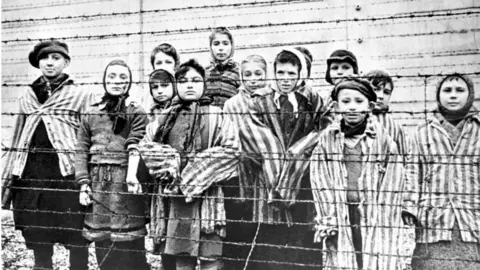 Getty Images
Getty ImagesUnder oath, he said: "During the summer of 1941, I was ordered to Berlin to receive orders personally from Reichsfuhrer SS Himmler.
"He said something like this - the Fuhrer has ordered the final solution of the Jewish problem. We, the SS, are entrusted with executing this order. He has chosen Auschwitz for logistical reasons."
He went on to say the camp's proximity to a railway and its isolated position were among the reasons the camp was chosen.
Höss's witness statement at Nuremberg was significant because while other senior officers denied offences and defended the actions of the Third Reich, he stated on the record the actions of the Nazis and the mass extermination of the Jewish people.
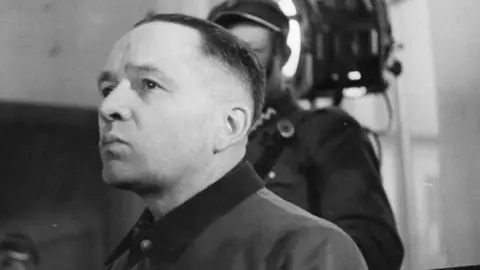 Getty Images
Getty ImagesHöss was later extradited to Poland where his trial in Warsaw began on 11 March 1947.
He was sentenced to death on 2 April 1947.
Höss was hanged on 16 April 1947 at the site of the former Auschwitz camp - the gallows stood at the remains of the camp's Gestapo building, next to the first crematorium at Auschwitz, and 100 metres from the villa where he had lived with his family.
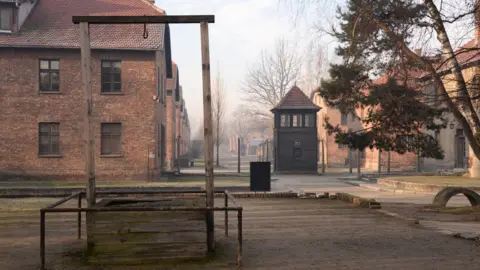 Paweł Sawicki/Auschwitz Memorial
Paweł Sawicki/Auschwitz MemorialCapt Cross returned to civilian life and continued to work in the family's leather firm until his retirement.
He died from cancer at the age of 75 on 15 June 1988.
His son William, now 71 and a farmer in Oakham, Rutland, recalls his father having lots of memorabilia including a Swastika flag, "but we never asked him about it", he says.
"Not even when we were playing with a pistol - he didn't come out and tell us where it came from - or say 'I got this from so and so'.
"It wasn't until my older [half] brother was going through father's things that so much came to light about what he had done."
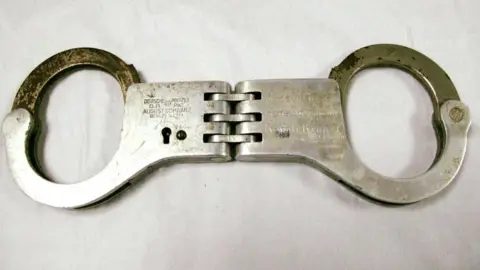 Military Intelligence Museum
Military Intelligence MuseumWilliam's half-brother, from Capt Cross's first marriage, now lives in Lymington in Hampshire.
Although Peter Cross was born before his father went overseas with the Intelligence Corps, Capt Cross did not share his experiences of the war with him either.
"He never spoke about it to me, but after he passed, I went through his things," the 82-year-old recalls.
Neither brother had realised until then the role their father had played in capturing one of the most notorious murderers of the Jewish people.
You can find out more about the role played by Capt Victor Cross on the BBC documentary Rise of the Nazis: The Manhunt.

Follow East of England news on Facebook, Instagram and X. Got a story? Email [email protected] or WhatsApp us on 0800 169 1830
